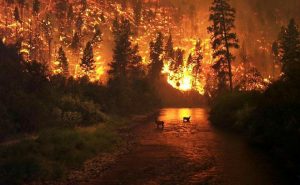-Carolyn Little
Over the past few weeks, I have learned how to become more sustainable without even realizing it. I believe that the process is very difficult in daily life. However, a friend recently told me the other day that “imperfect sustainability is okay because it is a learning process.” Ever since she told me these words, I have felt more comfortable with learning how to be more sustainable instead of being pressured to do so each day. Since this semester started, I have learned to become more sustainable by avoiding the emission of greenhouse gases. I knew that the emission of harmful chemicals in our environment was unhealthy beforehand, but I did not realize to what extent this affects our environment or how to prevent it. For example, a few years ago in 2016 when my family and I vacationed (again) in the Smoky Mountains solely for the purpose of going on multiple hiking trails, I heard that the Chimney Tops fire occurred merely days after we left. The fire was caused by two brainless people, who were (thankfully) arrested. The fire hit “11,000 acres, which [was] about 2% of the over 500,000 acres in the park boundaries” (National Park Service). This fire made me further appreciate the beauty of nature and be grateful that most of the animals survived the fire, while I also learned what greenhouse gases release into the atmosphere and how it affects the environment. This Chimney Tops fire, for example, released harmful gases like carbon dioxide, carbon monoxide, methane, and many other chemicals that are harmful to ecosystems and to organisms’ respiratory health. When trees are killed by fires, they release even more carbon dioxide into the atmosphere. Fires in general produce “aerosols, including black carbon and gases,” which block sunlight distribution and pollute the atmosphere by “warming the planet” (Berwyn). These gases cause climate change, which is detrimental to our planet’s health, organism’s health, and agricultural health.

One way that I have participated in helping prevent greenhouse gas emission during this semester is by biking instead of using my car. The majority of transportation vehicles release carbon dioxide into the air as well due to the “combustion of petroleum-based products,” like gasoline (EPA). In 2018, 28.2% of greenhouse gases that were released from the atmosphere were caused by vehicles, which still is the largest contributor of negative chemical emissions (EPA). A way to lower gas emission by transportation is by using public transportation more frequently, such as electric buses in China and Chile and/or bicycles, instead of individual vehicles, which can help “cut transport emissions [by] 80%” (Wang). I have helped prevent this emission by using my bike more often than I ever had in my life. It is even a good exercise tool as well! My watch tracks the distance I bike and says that it is about 2 miles to get to Plyler and back.
Overall, I did not realize to what extent greenhouse gases from transportation and fires affect our planet, but now I know that every bit of even a little sustainability counts in order to keep our environment safe and healthy.

Berwyn, Bob. “How Wildfires Can Affect Climate Change (and Vice Versa).” Inside Climate News, August 23, 2018. https://insideclimatenews.org/news/23082018/extreme-wildfires-climate-change-global-warming-air-pollution-fire-management-black-carbon-co2#:~:text=Wildfires%20emit%20carbon%20dioxide%20and,effects%20on%20warming%20and%20cooling
“Sources of Greenhouse Gas Emissions.” United States Environmental Protection Agency, https://insideclimatenews.org/news/23082018/extreme-wildfires-climate-change-global-warming-air-pollution-fire-management-black-carbon-co2#:~:text=Wildfires%20emit%20carbon%20dioxide%20and,effects%20on%20warming%20and%20cooling
“Chimney Tops 2 Fire.” National Park Service, Great Smoky Mountains, December 22, 2016. https://www.nps.gov/grsm/learn/chimney-tops-2-fire.htm
Wang, Shiying. “Everything You Need to Know About the Fastest Growing Source of Global Emissions: Transport.” World Resources Institute, October 16, 2019. https://www.wri.org/blog/2019/10/everything-you-need-know-about-fastest-growing-source-global-emissions-transport